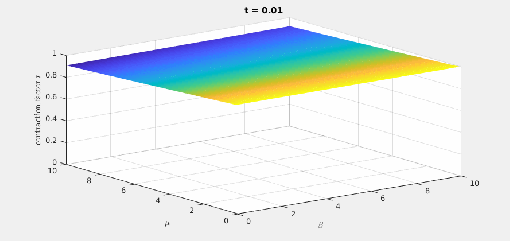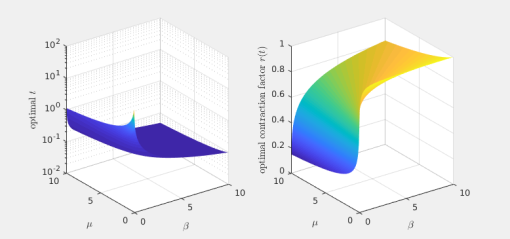I blogged about the Douglas-Rachford method before and in this post I’d like to dig a bit into the history of the method.
As the name suggests, the method has its roots in a paper by Douglas and Rachford and the paper is
Douglas, Jim, Jr., and Henry H. Rachford Jr., “On the numerical solution of heat conduction problems in two and three space variables.” Transactions of the American mathematical Society 82.2 (1956): 421-439.
At first glance, the title does not suggest that the paper may be related to monotone inclusions and if you read the paper you’ll not find any monotone operator mentioned. So let’s start and look at Douglas and Rachford’s paper.
1. Solving the heat equation numerically
So let us see, what they were after and how this is related to what is known as Douglas-Rachford splitting method today.
Indeed, Douglas and Rachford wanted to solve the instationary heat equation

with Dirichlet boundary conditions (they also considered three dimensions, but let us skip that here). They considered a rectangular grid and a very simple finite difference approximation of the second derivatives, i.e.

(with modifications at the boundary to accomodate the boundary conditions). To ease notation, we abbreviate the difference quotients as operators (actually, also matrices) that act for a fixed time step

With this notation, our problem is to solve

in time.
Then they give the following iteration:


(plus boundary conditions which I’d like to swipe under the rug here). If we eliminate  from the first equation using the second we get
from the first equation using the second we get

This is a kind of implicit Euler method with an additional small term  . From a numerical point of it has one advantage over the implicit Euler method: As equations (1) and (2) show, one does not need to invert
. From a numerical point of it has one advantage over the implicit Euler method: As equations (1) and (2) show, one does not need to invert  in every iteration, but only
in every iteration, but only  and
and  . Remember, this was in 1950s, and solving large linear equations was a much bigger problem than it is today. In this specific case of the heat equation, the operators
. Remember, this was in 1950s, and solving large linear equations was a much bigger problem than it is today. In this specific case of the heat equation, the operators  and
and  are in fact tridiagonal, and hence, solving with
are in fact tridiagonal, and hence, solving with  and
and  can be done by Gaussian elimination without any fill-in in linear time (read Thomas algorithm). This is a huge time saver when compared to solving with
can be done by Gaussian elimination without any fill-in in linear time (read Thomas algorithm). This is a huge time saver when compared to solving with  which has a fairly large bandwidth (no matter how you reorder).
which has a fairly large bandwidth (no matter how you reorder).
How do they prove convergence of the method? They don’t since they wanted to solve a parabolic PDE. They were after stability of the scheme, and this can be done by analyzing the eigenvalues of the iteration. Since the matrices  and
and  are well understood, they were able to write down the eigenfunctions of the operator associated to iteration (3) explicitly and since the finite difference approximation is well understood, they were able to prove approximation properties. Note that the method can also be seen, as a means to calculate the steady state of the heat equation.
are well understood, they were able to write down the eigenfunctions of the operator associated to iteration (3) explicitly and since the finite difference approximation is well understood, they were able to prove approximation properties. Note that the method can also be seen, as a means to calculate the steady state of the heat equation.
We reformulate the iteration (3) further to see how  is actually derived from
is actually derived from  : We obtain
: We obtain

2. What about monotone inclusions?
What has the previous section to do with solving monotone inclusions? A monotone inclusion is

with a monotone operator, that is, a multivalued mapping  from a Hilbert space
from a Hilbert space  to (subsets of) itself such that for all
to (subsets of) itself such that for all  and
and  and
and  it holds that
it holds that

We are going to restrict ourselves to real Hilbert spaces here. Note that linear operators are monotone if they are positive semi-definite and further note that monotone linear operators need not to be symmetric. A general approach to the solution of monotone inclusions are so-called splitting methods. There one splits  additively
additively  as a sum of two other monotone operators. Then one tries to use the so-called resolvents of
as a sum of two other monotone operators. Then one tries to use the so-called resolvents of  and
and  , namely
, namely

to obtain a numerical method. By the way, the resolvent of a monotone operator always exists and is single valued (to be honest, one needs a regularity assumption here, namely one need maximal monotone operators, but we will not deal with this issue here).
The two operators  and
and  from the previous section are not monotone, but
from the previous section are not monotone, but  and
and  are, so the equation
are, so the equation  is a special case of a montone inclusion. To work with monotone operators we rename
is a special case of a montone inclusion. To work with monotone operators we rename

and write the iteration~(4) in terms of monotone operators as

i.e.

Using  and
and  we rewrite this in terms of resolvents as
we rewrite this in terms of resolvents as
![\displaystyle \begin{array}{rcl} w^{n+1} & = &(I+\tau B)^{-1}[(I+\tau A)^{-1}(I-\tau B) + \tau B]w^{n}\\ & =& R_{\tau B}(R_{\tau A}(w^{n}-\tau Bw^{n}) + \tau Bw^{n}). \end{array}](https://s0.wp.com/latex.php?latex=%5Cdisplaystyle+%5Cbegin%7Barray%7D%7Brcl%7D+w%5E%7Bn%2B1%7D+%26+%3D+%26%28I%2B%5Ctau+B%29%5E%7B-1%7D%5B%28I%2B%5Ctau+A%29%5E%7B-1%7D%28I-%5Ctau+B%29+%2B+%5Ctau+B%5Dw%5E%7Bn%7D%5C%5C+%26+%3D%26+R_%7B%5Ctau+B%7D%28R_%7B%5Ctau+A%7D%28w%5E%7Bn%7D-%5Ctau+Bw%5E%7Bn%7D%29+%2B+%5Ctau+Bw%5E%7Bn%7D%29.+%5Cend%7Barray%7D+&bg=ffffff&fg=000000&s=0&c=20201002)
This is not really applicable to a general monotone inclusion since there  and
and  may be multi-valued, i.e. the term
may be multi-valued, i.e. the term  is not well defined (the iteration may be used as is for splittings where
is not well defined (the iteration may be used as is for splittings where  is monotone and single valued, though).
is monotone and single valued, though).
But what to do, when both and  and
and  are multivaled? The trick is, to introduce a new variable
are multivaled? The trick is, to introduce a new variable  . Plugging this in throughout leads to
. Plugging this in throughout leads to

We cancel the outer  and use
and use  to get
to get

and here we go: This is exactly what is known as Douglas-Rachford method (see the last version of the iteration in my previous post). Note that it is not  that converges to a solution, but
that converges to a solution, but  , so it is convenient to write the iteration in the two variables
, so it is convenient to write the iteration in the two variables

The observation, that these splitting method that Douglas and Rachford devised for linear problems has a kind of much wider applicability is due to Lions and Mercier and the paper is
Lions, Pierre-Louis, and Bertrand Mercier. “Splitting algorithms for the sum of two nonlinear operators.” SIAM Journal on Numerical Analysis 16.6 (1979): 964-979.
Other, much older, splitting methods for linear systems, such as the Jacobi method, the Gauss-Seidel method used different properties of the matrices such as the diagonal of the matrix or the upper and lower triangluar parts and as such, do not generalize easily to the case of operators on a Hilbert space.
-Lipschitz +
-strongly monotone, the iteration with stepsize
converges linear with rate
and
and
acts as time variable:

depending on the values of
and
.
there is a best
and also a smallest contraction factor
. Here are plots of these quantities:


